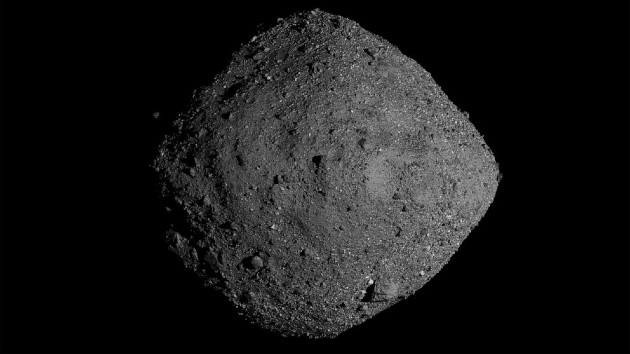NASA to skim the surface of an asteroid and bring a sample home
NASABy CATHERINE THORBECKE, ABC News
(NEW YORK) — NASA is set to touch an asteroid, break off a sample, and bring it back to Earth for the first time during a history-making mission that culminates on Tuesday.
The OSIRIS-REx spacecraft — an acronym for Origins, Spectral Interpretation, Resource Identification and Security-Regolith Explorer — is set to attempt a touch-and-go sample collection on the asteroid Bennu starting Tuesday afternoon.
“It feels like something really amazing is about to happen,” Thomas Zurbuchen, the associate administrator of NASA’s Science Mission Directorate, said at a news conference Monday.
“This is a historic first mission for NASA, returning an asteroid sample, and it is hard. It is hard even without COVID, but COVID made it even harder,” he added, lauding the team effort that went into Tuesday’s big event.
The spacecraft launched four years ago, has been orbiting Bennu for two years. On Tuesday, it will briefly touch its surface via a robotic arm at 6:12 p.m. ET for less than a minute to grab a sample.
The spacecraft is then expected to remain in Bennu’s orbit until 2021, when it will begin its journey home. It’s expected to land back on Earth with the sample in 2023.
Starting at just before 2 p.m. ET Tuesday, the Osiris-REx will begin its set of maneuvers to slowly descend to the Nightingale landing spot on the surface of the asteroid, which is expected to take over four hours. NASA will broadcast a stream of animations displaying the sample collection activities in real time starting at 1:20 p.m. ET on its website.
Starting at 5 p.m. ET, there will be also be a live broadcast from Lockheed Martin of the Osiris-REx’s descent to the surface and sample collection attempt. This livestream can also be watched on NASA’s website.
If successful, this will be the first time NASA has grabbed a piece of an asteroid in space.
The spacecraft and asteroid are some 207 million miles from Earth during the touch-and-go mission, so it takes approximately 18.5 minutes for signals to travel from Earth to the spacecraft — meaning the “live” broadcasts will actually be 18.5 minutes after the events in space happened.
This also means that ground control will not be able to command the activity during the event, so the spacecraft will complete it almost entirely autonomously.
The OSIRIS-REx is slated to collect at least 2 ounces of Bennu’s rocky material — about the size of a Snickers bar — to bring back to Earth. If successful, this will be the largest sample returned from space since the Apollo program, according to NASA.
“Asteroids are like time capsules floating in space that can provide a fossil record of the birth of our solar system,” Lori Glaze, the planetary science division director at NASA, said in a news conference Monday. “They can provide valuable information about how the planets including our own came to be.”
While Glaze acknowledged asteroids can also pose an impact threat to Earth, she offered reassurance that there are currently no known asteroids that are an impact threat to Earth over the next 100 years. Bennu, Glaze said, has a 1-in-2,700 chance of hitting Earth at the end of the next century.
Dr. Jamie Elsila, a research scientist at NASA Goddard Space Flight Center, said one of the primary goals of the mission “is to understand the origins of the solar system, and that includes the origins of life on Earth.”
While they are not looking for life or evidence of life on Bennu, Elsila said they are excited about the organic compounds they expect to find on Bennu, and “the role that asteroids might have played in delivering these life-forming compounds to Earth.”
Zurbuchen said Bennu is “almost a Rosetta Stone.”
The asteroid “tells the history of our entire Earth, of the solar system, during the last billions of years — and the violent evolution of that history as well,” Zurbuchen said.
Copyright © 2020, ABC Audio. All rights reserved.

